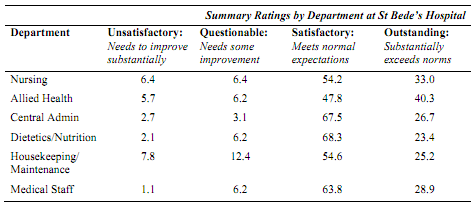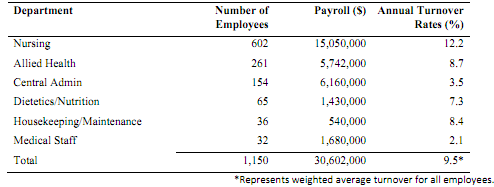Reference no: EM13988
The primary purpose of this assessment task is to help students develop skills in the use of Human Resource Management (HRM) principles, theories and models in the analysis of the human resource practices in a service industry organisation. The assignment requires you to analyse the current situation and identify HRM issues related to the downsizing of a not-for-profit hospital.
The secondary purpose of this assignment is to give students the opportunity to further develop research, analysis and problem identification skills, as well as skills in presenting an argument for change within the framework of a business report.
Case study: Downsizing at St Bede's
St Bede's Hospital is a medium-sized, 400-bed hospital in a regional Australian city. It was established in 1908 by the Sisters of Mercy, an order of Catholic sisters. The facility has grown gradually over the years and is now the third largest hospital in the city. It is entirely non-union and has never experienced an employee layoff since its inception.
Sister Mary Josephine has been the Chief Executive Officer on the hospital for 11 years. Eight years ago, she hired Ms Sharon Osgood as Director of Personnel. Osgood has an M.A. in Human Resource Management and has been instrumental in formalising the institution's human resources' policies and procedures.
Hospital occupancy rates had run between 76 and 82 percent from 1970 to 1982. However, since then, occupancy had gradually fallen to 57 percent. Such declines have not been unusual for this industry during this time period as a result of changing reimbursement policies, emphasis on outpatient services, and increasing competition. However, the declining occupancy rate has affected this hospital's revenues to such an extent that it ran a deficit for the first time last year. The only response to these changes thus far has been a tightening of requirements for equipment or supply purchases.
At the most recent quarterly meeting of the Board of Governors, Sister Mary Josephine presented the rather bleak financial picture. The projected deficit for the coming year was $3,865,000 unless some additional revenue sources were identified or some additional savings were found. The Board's recommendation, based on the immediate crisis and need to generate short-term savings, was that employee layoffs were the only realistic alternative. They recommended that Sister Mary Josephine consider laying off up to 10 percent of the hospital's employees with an emphasis on those in the "nonessential" areas.
Sister Mary Josephine responded that the hospital's employees had never been laid off in the history of the institution. Moreover, she viewed the employees as part of the "family" and would have great difficulty in implementing such a layoff. Nevertheless, since she had no realistic short-term alternative for closing the "revenue gap", she reluctantly agreed to implement a layoff policy which would be as
fair as possible to all employees, with a guarantee of reemployment for those laid off, and to find additional revenue sources so that layoffs would be unnecessary in the future.
Sister Mary Josephine called Sharon Osgood into her office the next morning, shared her concerns, and asked her to prepare both a short-term plan to save $3 million over the next year through employee layoffs as well as a long-term plan to avoid layoffs in the future. Her concerns were that the layoffs themselves might be costly in terms of lost investment in some of the laid-off employees, lost
efficiency, potential lawsuits, and lower morale. She was concerned that the criteria for the layoffs not only be equitable, but also appear to be equitable to the employees. She also wanted to make sure that those being laid off received "adequate" notice so they could make alternative plans or so that the hospital could assist them with finding alternative employment. Since the hospital had no previous experience with employee layoffs, and no union contract constraints, her feeling was that both seniority and job performance should be considered in determining who would be laid off.
Sharon knew the hospital's performance appraisal system was inadequate, and needed to be revamped. While this task was high on her "to do" list, she also knew she had to move ahead with her recommendations on layoffs immediately. The present performance appraisal system uses a traditional checklist rating scale with a summary rating. Since there is no forced distribution, the average ratings of employees in different departments vary widely.
Table 1 shows the summary ratings of employees in each department. Most supervisors in all departments rate many of their subordinates either "satisfactory" or "outstanding". Sharon has done a quick review of those employees whose overall ratings were "unsatisfactory" or "questionable". Most are employees with less than three years of seniority, whereas the "satisfactory" employees had worked for St Bede's for an average of around seven years. Table 2 provides a summary of the distribution of employees and payroll expenses by department for the most recent year.
Table 1. Percentage Distribution of Performance Appraisal

Table 2. Employment and Payroll Expenditures Distribution

Task
As the Personnel Director at St Bede's, you are charged with the task of developing a report that informs the CEO of the options available to the hospital under the Fair Work Act (2009). The report should explain the advantages and disadvantages of each option, and explore the consequences of the various options for industrial relations and human resource management within the organisation. Your report should offer the CEO concrete, actionable recommendations that will save the hospital the required $3 million, and at the same time, minimise harm to laid-off workers, remaining staff, and the hospital itself. Due attention should be paid to means of preventing any future need for layoffs. It is important that your recommendations be based on appropriate HRM literature and properly referenced.
The report should be a confidential report for the Chief Executive Officer of St Bede's Hospital, and be presented as a suitably professional document. This assessment item involves researching your assigned topic to enhance your understanding of Human Resource Management (HRM) concepts and utilisation of academic literature. Whilst you should AVOID using only textbooks, the prescribed textbook for the course should be cited in regard to broad human resource management principles. You will be expected to present information and evidence from, and cite, at LEAST eight (8) relevant peer-reviewed, academic journal articles (absolute minimum requirement). Refer to your recommended readings for examples of academic journals. While you can cite these articles, you must find eight (8) peer reviewed journal articles not listed in the course materials. The quality and number of citations will demonstrate the breadth and depth of the literature used to answer the questions. Your marker is interested in the analysis that you have developed from YOUR review of the literature and how well you use the literature to respond to the topic.